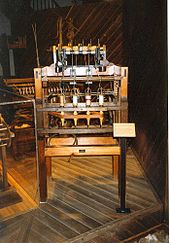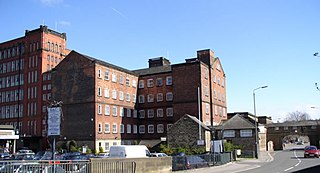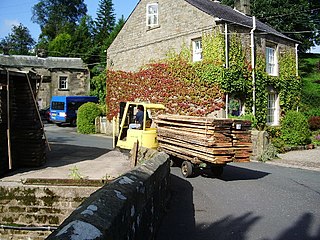

The water frame is a spinning frame that is powered by a water-wheel.


The water frame is a spinning frame that is powered by a water-wheel.
Richard Arkwright, who patented the technology in 1769, [1] designed a model for the production of cotton thread, which was first used in 1765. [2] [3] The Arkwright water frame was able to spin 96 threads at a time, which was an easier and faster method than ever before. [4] The design was partly based on a spinning machine built for Thomas Highs by clockmaker John Kay, who was hired by Arkwright. [5] Being run on water power, it produced stronger and harder yarn than the "spinning jenny", and propelled the adoption of the modern factory system. [6]
Another water-powered frame for the production of textiles was developed in 1760 in the early industrialized town of Elberfeld, Prussia (now in Wuppertal, Germany), by German bleach plant owner Johann Heinrich Bockmühl. [7] [8]
The name water frame is derived from the use of a water wheel to drive a number of spinning frames. The water wheel provided more power to the spinning frame than human operators, reducing the amount of human labor needed and increasing the spindle count dramatically. However, unlike the spinning jenny, the water frame could spin only one thread at a time until 1779, when Samuel Compton combined the two inventions into his spinning mule, which was more effective.
The water frame was originally powered by horses at a factory built by Arkwright and partners in Nottingham. In 1770, Arkwright and his partners built a water-powered mill in Cromford, Derbyshire.
In 1771, Arkwright installed the water frame in his cotton mill at Cromford, Derbyshire, on the River Derwent, creating one of the first factories that was specifically built to house machinery rather than just bring workers together. It was one of the first instances of the working day being determined by the clock instead of the daylight hours and of people being employed rather than just contracted. In its final form, combined with his carding machine, it was the first factory to use a continuous process from raw material to finished product in a series of operations. [9]
Arkwright played a significant role in the development of the factory system as he combined water power, the water frame, and continuous production with modern employment practices.
The water frame played a significant role in the development of the Industrial Revolution – first in England, [10] but soon also in continental Europe after German entrepreneur Johann Gottfried Brügelmann managed to find out details of the technology, which had been kept very secret; disclosure of details was punishable by the death penalty. Brügelmann managed to build working water frames and used them to open the first spinning factory on the continent, built in 1783 in Ratingen and also named "Cromford", from where the technology spread over the world. The factory building today hosts a museum, which is the world's only place to see a functioning water frame. [11]
Samuel Slater brought the water frame to America, circumventing the 1774 English ban on textile workers leaving and memorizing details of its construction; he left for New York in 1789. [12] Moses Brown and Slater partnered to create the Slater Mill in Pawtucket in 1793, the first water-powered machine to make thread in America. [13]

Derwent Valley Mills is a World Heritage Site along the River Derwent in Derbyshire, England, designated in December 2001. It is administered by the Derwent Valley Mills Partnership. The modern factory, or 'mill', system was born here in the 18th century to accommodate the new technology for spinning cotton developed by Richard Arkwright. With advancements in technology, it became possible to produce cotton continuously. The system was adopted throughout the valley, and later spread so that by 1788 there were over 200 Arkwright-type mills in Britain. Arkwright's inventions and system of organising labour was exported to Europe and the United States.

Sir Richard Arkwright was an English inventor and a leading entrepreneur during the early Industrial Revolution. He is credited as the driving force behind the development of the spinning frame, known as the water frame after it was adapted to use water power; and he patented a rotary carding engine to convert raw cotton to 'cotton lap' prior to spinning. He was the first to develop factories housing both mechanised carding and spinning operations.

Samuel Slater was an early English-American industrialist known as the "Father of the American Industrial Revolution", a phrase coined by Andrew Jackson, and the "Father of the American Factory System". In the United Kingdom, he was called "Slater the Traitor" and "Sam the Slate" because he brought British textile technology to the United States, modifying it for American use. He memorized the textile factory machinery designs as an apprentice to a pioneer in the British industry before migrating to the U.S. at the age of 21.

Jedediah Strutt or Jedidiah Strutt – as he spelled it – was a hosier and cotton spinner from Belper, England.

Cromford is a village and civil parish in Derbyshire, England, in the valley of the River Derwent between Wirksworth and Matlock. It is 17 miles (27 km) north of Derby, 2 miles (3.2 km) south of Matlock and 1 mile (1.6 km) south of Matlock Bath. It is first mentioned in the 11th-century Domesday Book as Crumforde, a berewick of Wirksworth, and this remained the case throughout the Middle Ages. The population at the 2011 Census was 1,433. It is principally known for its historical connection with Richard Arkwright and the nearby Cromford Mill, which he built outside the village in 1771. Cromford is in the Derwent Valley Mills World Heritage Site.

A cotton mill is a building that houses spinning or weaving machinery for the production of yarn or cloth from cotton, an important product during the Industrial Revolution in the development of the factory system.

Textile manufacture during the British Industrial Revolution was centred in south Lancashire and the towns on both sides of the Pennines in the United Kingdom. The main drivers of the Industrial Revolution were textile manufacturing, iron founding, steam power, oil drilling, the discovery of electricity and its many industrial applications, the telegraph and many others. Railroads, steamboats, the telegraph and other innovations massively increased worker productivity and raised standards of living by greatly reducing time spent during travel, transportation and communications.

The spinning frame is an Industrial Revolution invention for spinning thread or yarn from fibres such as wool or cotton in a mechanized way. It was developed in 18th-century Britain by Richard Arkwright and John Kay.

The spinning mule is a machine used to spin cotton and other fibres. They were used extensively from the late 18th to the early 20th century in the mills of Lancashire and elsewhere. Mules were worked in pairs by a minder, with the help of two boys: the little piecer and the big or side piecer. The carriage carried up to 1,320 spindles and could be 150 feet (46 m) long, and would move forward and back a distance of 5 feet (1.5 m) four times a minute.
John Kay was an English inventor best known for the development of the spinning frame in 1767, which marked an important stage in the development of textile manufacturing during the Industrial Revolution. Born in Warrington in Lancashire, England, Kay was at least the co-constructor of the first spinning frame, and was a claimant to having been its inventor. He is sometimes confused with the unrelated John Kay from Bury, Lancashire, who had invented the flying shuttle, a weaving machine, some thirty years earlier.

Cotton-spinning machinery is machines which process prepared cotton roving into workable yarn or thread. Such machinery can be dated back centuries. During the 18th and 19th centuries, as part of the Industrial Revolution cotton-spinning machinery was developed to bring mass production to the cotton industry. Cotton spinning machinery was installed in large factories, commonly known as cotton mills.

The Slater Mill is a historic water-powered textile mill complex on the banks of the Blackstone River in Pawtucket, Rhode Island, modeled after cotton spinning mills first established in England. It is the first water-powered cotton spinning mill in America to utilize the Arkwright system of cotton spinning as developed by Richard Arkwright.

Belper North Mill, also known as Strutt's North Mill in Belper, is one of the Derwent Valley Mills, given UNESCO World Heritage Status in 2001.

Cromford Mill is the world's first water-powered cotton spinning mill, developed by Richard Arkwright in 1771 in Cromford, Derbyshire, England. The mill structure is classified as a Grade I listed building. It is now the centrepiece of the Derwent Valley Mills UNESCO World Heritage Site, and is a multi-use visitor centre with shops, galleries, restaurants and cafes.

Sir Richard Arkwright's Masson Mill is a water-powered cotton spinning mill situated on the west bank of the River Derwent in Matlock Bath, Derbyshire in England. This mill was built in 1783. It forms part of the Derwent Valley Mills, a World Heritage Site. Nearby is Willersley Castle, the house Richard Arkwright built for himself within the parish of Matlock.

Ring spinning is a spindle-based method of spinning fibres, such as cotton, flax or wool, to make a yarn. The ring frame developed from the throstle frame, which in its turn was a descendant of Arkwright's water frame. Ring spinning is a continuous process, unlike mule spinning which uses an intermittent action. In ring spinning, the roving is first attenuated by using drawing rollers, then spun and wound around a rotating spindle which in its turn is contained within an independently rotating ring flyer. Traditionally ring frames could only be used for the coarser counts, but they could be attended by semi-skilled labour.

Kirk Mill is an early example of an Arkwright-type cotton mill and a grade II listed building in Chipping, Lancashire. Built in the 1780s on the site of a corn mill dating back to at least 1544, it operated as a cotton mill with water frames and then throstles until 1886 when it was sold and repurposed as H.J. Berry's chairmaking factory, powered by a 32 ft (9.8 m) waterwheel, which continued in use, generating electricity until the 1940s.

The Textilfabrik Cromford in Ratingen, North Rhine-Westphalia, Germany was built in 1783 by Johann Gottfried Brügelmann. It was the first cotton spinning mill on the European mainland. Today it is an industrial museum specialising in textile history.

Lumsdale Valley is a steep-sided wooded gorge in the Peak District near Matlock, Derbyshire, in England. It is the location of a series of historic water-powered mills.

Low Mill is a former textile mill in Keighley, West Yorkshire, England. It was the first industrial building in Keighley, and the first mill in Yorkshire to spin cotton, however, it later changed to being a worsted mill. The mill is now derelict and is a grade II* listed building, one of two in the town of Keighley. Its state of dereliction has led Historic England to place it on their 'at risk' register.
{{cite web}}: CS1 maint: numeric names: authors list (link)